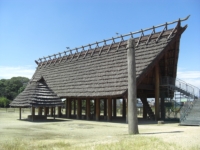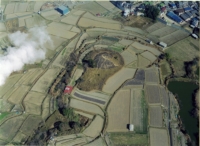Izumi City
Click on the photo to enlarge.
| City Area | 84.982 kilometers |
|---|---|
| City Population | 186,906 people (As of the end of January 2011) |
| No. of households | 72,411 households (As of the end of January 2011) |
| City hall address | 2-7-5 Fuchu-cho, Izumi 594-8501 |
| Industrial promotion departments | Izumi, Environment and Industry Dept. Commerce and Tourism Div. |
| Phone | 0725-41-1551 |
| Fax | 0725-45-9352 |
| City webpage | https://www.city.osaka-izumi.lg.jp/index.html |
| Catch Copy | Izumi - A vibrant city where people shine and are happy |
| Local industries 1 | Art glass |
| Local industries 2 | Artificial pearls |
| Local industries 3 | Cotton products |
| Industry & History | Izumi is blessed to have a mild climate and it has been confirmed that people have lived here for over 10,000 years since the preceramic period. At one of the best and largest ancient sites in Japan, the Ikegami-Sone Historical Site, a Yayoi culture mainly of cultivating rice was firmly in place over 2,000 years ago. At the end of the 4th century, the Izumi Koganezuka Ancient Tomb was built during the year 236, the same year that princess Himiko left for China and the area is known for the discovery of a bronze mirror she carried. During the Nara Period, the Kawachi kingdom was separated and the Izumi kingdom established, with the government being set up in Fuchu-cho within Izumi city. From then on the area was the center of economic and political development in the Izumi kingdom. Within the city, the growing of rice has always been a major industry but during the Edo Period, cotton growing was popular and Izumi cotton was carried to Edo and Osaka. Following this tradition, even after the Meiji era and into the 1970's the textile industry which used cotton was the major industry in the city. In the southern mountainous regions bamboo and mandarin oranges have been known as specialty products since the Edo Period and the area is proud to be the largest grower of mandarin oranges in Osaka Prefecture. During peak months, the oranges are not just sold within Japan but are exported to North America as well. Other traditional local industries include the flower growing region of Kuwabara that is said to have started by Chogen, who worked to rebuild Toudai Temple during the beginning of the Kamakura Period, by bringing back a daffodil bulb from Song in China. Glasswork and artificial pearl manufacturing developed in Shinoda since long ago and skilled craftsman use their skills polished over years of work and well-honed senses to create profound works of art. Artificial pearls known by the name "I Pearl" are a major accessory that is representative of Japan and I Pearls are currently exported to various places around the world. In recent years Izumi has been working to create a new vibrant environment for families and businesses by developing suburbs and adjacent to them is a large industrial park called Techno Stage Izumi. |
| Manufacturer's Association | Izumi Chamber of Commerce |
|---|---|
| Location | 4-20-2 Fuchu-cho, Izumi 594-0071 |
| Phone | 0725-46-4141 |
| Fax | 0725-46-8686 |
| HP(URL) | https://www.izumicci.jp |
| Manufacturer's Association | Japanese Artificial Pearl & Glass Work Cooperative |
|---|---|
| Location | 2-2-19 Onoi-cho, Izumi 594-0006 |
| Phone | 0725-41-2133 |
| Fax | 0725-41-2135 |
| HP(URL) | None |
| Manufacturer's Association | Senshu Textile Industry Cooperative |
|---|---|
| Location | 1-30-9 Wake-cho, Izumi 594-0073 |
| Phone | 0725-41-0124 |
| Fax | 0725-41-7990 |
| HP(URL) | https://senshu-textile.jp/ |



